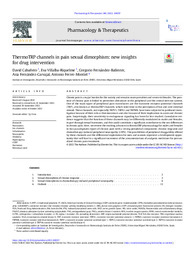Please use this identifier to cite or link to this item:
https://hdl.handle.net/11000/35238Full metadata record
| DC Field | Value | Language |
|---|---|---|
| dc.contributor.author | Cabañero, David | - |
| dc.contributor.author | Villalba Riquelme, Eva María | - |
| dc.contributor.author | Fernández Ballester, Gregorio | - |
| dc.contributor.author | Fernández Carvajal, Asia | - |
| dc.contributor.author | Ferrer-Montiel, Antonio | - |
| dc.contributor.other | Departamentos de la UMH::Bioquímica y Biología Molecular | es_ES |
| dc.date.accessioned | 2025-01-24T12:21:15Z | - |
| dc.date.available | 2025-01-24T12:21:15Z | - |
| dc.date.created | 2022 | - |
| dc.identifier.citation | Pharmacology&Therapeutics 240 (2022) 108297 | es_ES |
| dc.identifier.issn | 1879-016X | - |
| dc.identifier.issn | 0163-7258 | - |
| dc.identifier.uri | https://hdl.handle.net/11000/35238 | - |
| dc.description.abstract | Chronicpainisamajorburdenforthesocietyandremainsmoreprevalentandsevereinfemales.Thepresenceofchronicpainislinkedtopersistentalterationsintheperipheralandthecentralnervoussystem. Oneof themaintypesofperipheralpaintransducersarethetransient receptorpotential channels (TRP),alsoknownasthermoTRPchannels,whichinterveneintheperceptionofhotandcoldexternal stimuli.Thesechannels,andespeciallyTRPV1,TRPA1andTRPM8,havebeensubjectedtoprofoundinvestigationbecauseoftheirroleasthermosensorsandalsobecauseoftheirimplicationinacuteandchronic pain.Surprisingly, theirsensitivitytoendogenoussignalinghasbeenfarlessstudied.Cumulativeevidencesuggeststhatthefunctionofthesechannelsmaybedifferentlymodulatedinmalesandfemales, inpartthroughsexualhormones,andthiscouldconstituteasignificantcontributortothesexdifferences inchronicpain.Here,wereviewtheexcitingadvancesinthermoTRPpharmacologyformalesandfemales intwoparadigmatictypesofchronicpainwithastrongperipheralcomponent:chronicmigraineand chemotherapy-inducedperipheralneuropathy(CIPN).Thepossibilitiesofperipheraldruggabilityoffered bythesechannelsandthedifferentialexploitationformenandwomenrepresentadevelopmentopportunitythatwill leadtoasignificantincrementofthearmamentariumofanalgesicmedicinesforpersonalizedchronicpaintreatment. | es_ES |
| dc.format | application/pdf | es_ES |
| dc.format.extent | 18 | es_ES |
| dc.language.iso | eng | es_ES |
| dc.publisher | Elsevier | es_ES |
| dc.rights | info:eu-repo/semantics/openAccess | es_ES |
| dc.rights.uri | http://creativecommons.org/licenses/by-nc-nd/4.0/ | * |
| dc.subject | Nociceptors | es_ES |
| dc.subject | Ionchannels | es_ES |
| dc.subject | Inflammation | es_ES |
| dc.subject | Neuropathic | es_ES |
| dc.subject | Allodynia | es_ES |
| dc.subject | Hyperalgesia | es_ES |
| dc.subject | CGRP | es_ES |
| dc.subject | Hormones | es_ES |
| dc.subject | Menstrualcycle | es_ES |
| dc.subject.other | CDU::5 - Ciencias puras y naturales::57 - Biología | es_ES |
| dc.title | ThermoTRP channels in pain sexual dimorphism: new insights for drug intervention | es_ES |
| dc.type | info:eu-repo/semantics/article | es_ES |
| dc.relation.publisherversion | https://doi.org/10.1016/j.pharmthera.2022.108297 | es_ES |

View/Open:
1-s2.0-S0163725822001917-main.pdf
2,48 MB
Adobe PDF
Share:
.png)
